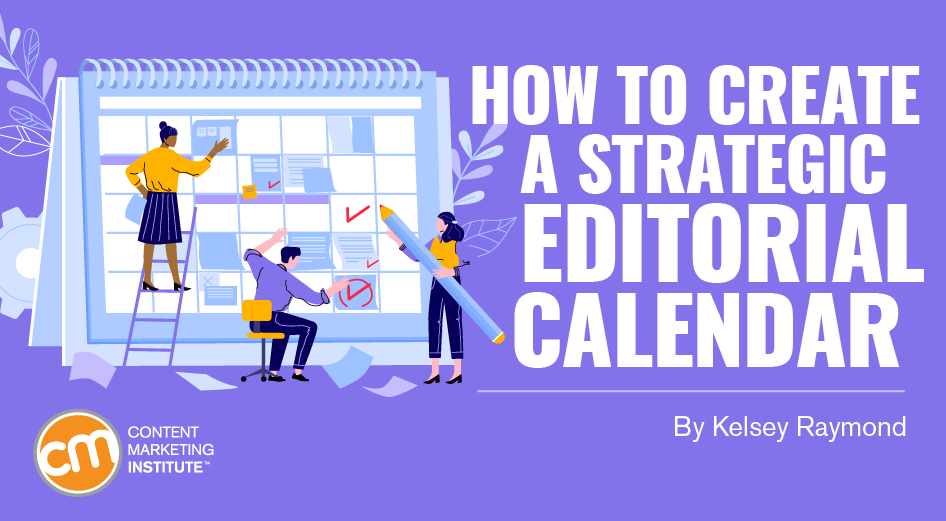MARKETING
7 Steps to a More Strategic Editorial Calendar

Updated January 6, 2022
Too many companies focus on the logistics of their editorial calendar – what days content is publishing, at what times, and at what cadence – and ignore the strategic elements. Anyone can schedule blog posts regularly, but the best content marketers create robust, strategic editorial calendars.
Instead of thinking of your editorial calendar as a schedule of content, consider it the implementation plan for your documented content marketing strategy. While the strategy most likely won’t change dramatically over a year, your editorial calendar will. Plan content in quarterly sprints so you can adapt topics to real-time changes in the industry and content based on real-time performance.
Plan #content in quarterly sprints so you can adapt topics to real-time changes in the industry, says @Kelsey_M_Meyer via @CMIContent. Click To Tweet
This seven-step guide details how to build an effective editorial calendar by:
- Determining who needs to be included
- Identifying goals for the quarter
- Deciding the content mix and publishing cadence to support those goals
- Documenting your mix and cadence decisions on the editorial calendar
- Brainstorming topics
- Planning for flexibility
- Measuring results to determine the success of your plan.
Step 1: Plan content creation capacity by determining who is involved
The best content assets should be influenced by a range of viewpoints, not just one person in the marketing department. The people involved should include subject-matter experts, writers, editors, graphic designers, distribution specialists, and potentially an outsourced content creation partner.
The best #content assets should be influenced by a range of viewpoints, not just one person in the marketing department, says @Kelsey_M_Meyer via @CMIContent. Click To Tweet
While most of these roles represent the content creators and distributors, subject-matter experts are different. Their primary duties are not about creating content. Build relationships with subject-matter experts who can offer specialized insight into relevant topics for your editorial calendar. These individuals should make sense as the “faces” of your company. They also should be willing (or required) to make time to serve as a subject-matter expert.
TIP: I’ve seen great results from interviewing subject-matter experts on topics, then writing the content and getting their approval on the draft. You and your marketing team are the experts on writing engaging content. Leave the writing to your team and use the SMEs to share unique insights.
Once you decide who will be involved, you need to determine how much time each can devote to the content over the quarter. (And later, you’ll use that information to detail the quantity and type of content assets to be created and distributed over the three months.)
In practice, you’ll need to decide how many SMEs you can rely on and how many hours they can devote across the quarter.
If each of three SMEs can devote six hours over the quarter, for example, you could create nine pieces of long-form content. Figure one hour of the SME’s time per article for an interview, then one hour per article to review and approve the draft. (That’s two hours per article and three articles per expert.) You would end up with nine articles by the end of the quarter.
If you have 10 additional SMEs and each can devote two hours over the quarter, each SME could do a two 30-minute interviews and 30-minute draft reviews. You would end up with 20 blog posts at the end of the quarter.
Then consider how many additional content pieces your team can create without SME involvement. The total (SME-supported pieces plus the pieces your team can create on its own) is your capacity for the quarter.
HANDPICKED RELATED CONTENT:
Step 2: Identify your goals for the quarter
Now that you’ve determined your content marketing capacity, think through your goals this quarter and how content plays into them.
I’ve found most companies have one of these three goals for their content marketing:
- Improving brand awareness through thought leadership
- Increasing leads generated through content
- Improving search rankings for targeted keywords (SEO)
Pick your primary goal for the quarter. It will give you a clearer view of the content types that should be created and the topics to focus on. Consider these examples:
- Goal: Improving brand awareness through thought leadership
Content mix: Heavy on guest articles in relevant publications and videos; topics geared toward areas of subject-matter expertise
Content mix: A new piece of gated content; guest-contributed articles that include landing page links to your site
Content mix: Topics determined by a keyword research report; heavily geared toward on-site content with some guest-contributed articles with backlinks
Step 3: Determine your content mix for the quarter
Use the insights you’ve gained from identifying your team’s capacity and goal to develop your ideal content mix for the quarter. You can create dozens of content types, including guest-contributed articles, videos, case studies, and static or interactive infographics. If you’re tight on capacity, stick with written content because it’s the least expensive to produce and the easiest to create with a small team.
Create your ideal #content mix based on available resources and a single goal, says @Kelsey_M_Meyer via @CMIContent. Click To Tweet
Using the team capacity described above with a goal of lead generation, here’s what a well-aligned content mix would look like:
- Six unique-topic, guest-contributed articles with backlinks targeted to publications visited by prospective customers
- 18 blog posts on your site – three posts for each topic addressed in the six guest-contributed articles
- Two gated pieces of content (white papers) – each long-form guide aligned with nine blog posts
- Two drip campaigns (one for each white paper)

HANDPICKED RELATED CONTENT:
Step 4: Specify details on the editorial calendar
This fourth step is where a lot of people start the editorial calendar process – plotting the calendar. But this step involves more than plotting the day each content asset publishes.
Work backward from the ideal publishing date and schedule the following dates on the calendar:
- Topics confirmed
- Author assigned
- Questions submitted to subject-matter expert (or outline created for the writer)
- Answers submitted from subject-matter experts
- Content piece draft completed
- Content piece edited
- Content piece approved (also note who is the final approver for the piece)
- Content piece uploaded to a platform or submitted to a publication
By including each of these dates on the calendar, you’ve taken what was once a vision – “we hope we can publish this many pieces of content in a quarter” – and turned it into a plan of what you can do based on the timeline you’ve laid out.
This calendar also serves as a one-stop shop that enables everyone involved to stay up to date on progress and due dates.
Make sure to assess other priorities and activities – those which you control and those which you can’t, such as product launches, big company events, holidays, guest publication dates, etc. Figure those into your planning process too.
By thinking through all of this on the front end, you’re less likely to end up with an editorial calendar that needs to keep changing. Though some things will change, plotting the deadlines you do control will help you and your team stay sane.
Step 5: Brainstorm to finalize the topics for each content piece
Now that you’ve scheduled the content for the quarter, it’s time to determine what you’ll be writing about. This step comes late in the process because brainstorming is more focused when you’ve accounted for your available resources, overall goal, and quantity of content pieces.
Brainstorming is better as a later step. After you know resources, goal, & content mix, says @Kelsey_M_Meyer via @CMIContent. Click To Tweet
Using our example, we now know:
- The content campaign needs two overarching themes to create the two cornerstone pieces — the white papers.
- Those two broad themes must be broken down into nine naturally aligned blog posts.
- Those themes and blog posts also must relate to six relevant and engaging guest-contributed articles.
You also know who is going to author each piece of content as well as which subject-matter experts are involved. You can vet a brainstormed topic by asking “Can this person speak to this?” or “Is this person an expert on the topic?” This procedure will ensure that you end up with the best content.
A free-for-all brainstorming session can be fun, but it doesn’t result in the most productive meeting. Create a structure for your brainstorming sessions to ensure that they stay on track. Here’s an agenda for my company’s 60-minute brainstorming meetings:
- 10 minutes – update on what’s in progress
- 20 minutes – brainstorming relevant blog ideas
- 20 minutes – brainstorming guest-contributed article ideas
- 10 minutes – confirming deadlines and responsibilities and updating the editorial calendar
The important thing is to brainstorm a group of topics at once to ensure that they align. This is the difference between a plan to produce a bunch of content and a strategic content marketing plan.
HANDPICKED RELATED CONTENT:
Step 6: Practice consistency and build flexibility into the plan
Companies make their biggest mistakes with their editorial calendars by putting in a ton of work on the front end and not following through. This happens for a lot of reasons. A boss pops in at the last minute with random content requests. Another executive needs a blog post to cover a conference where he or she is speaking, or news in the industry demands a fresh guest-contributed article commenting on the impact.
Companies make their biggest mistakes with their #editorial calendars by putting in a ton of work on the front end and not following through, says @Kelsey_M_Meyer via @CMIContent. Click To Tweet
You can handle this two ways:
- Throw the editorial calendar out the window and change focus every week based on the whims of the team. (I don’t recommend this.)
- Build flexibility into the editorial calendar. (I recommend this.)
You might have noticed that our example content mix doesn’t use the team’s capacity for the quarter. This is intentional.
Based on the resources available, the team could produce up to 17 more pieces of content. But by not building out the plan to capacity, I built in flexibility to work on other pieces of content as they arise.
TIP: If one person in your company is known for coming up with a different, must-do random thing every week, build that into the plan. Simply schedule a spot for “Joe’s Crazy Content Idea” each week.
The important thing is to let your content plan set up your brand for success. When an unexpected request pops up, it doesn’t distract the team from the planned content mix because you built in a capacity for flexibility.
Step 7: Measure your content success
The metrics to gauge the success of your editorial calendar are based on your content marketing goals. However, I recommend tracking these bare minimum metrics to see how well your content is performing against your goal:
- Metrics for brand awareness – social shares on published guest-contributed articles, clicks back to your website, new connections on LinkedIn, and people reaching out to your subject-matter experts
- Metrics for lead generation – clicks back to your website from published guest-contributed content, the conversion rate for blog posts, new leads generated from gated content
- Metrics for SEO – links earned through published guest-contributed content, traffic from organic search, rankings for your target keywords
HANDPICKED RELATED CONTENT:
Be strategic from the first step
Following a strategic approach to your editorial calendar is a never-ending process. But that ongoing work should be affected by your evaluation process. Review your key metrics toward the end of the quarter as you begin to plan for your next three months.
It gets easier each time you plan the editorial calendar for the next quarter because you’re simply tweaking your previous plan rather than starting from scratch. Let me know in the comments how this seven-step guide to creating your next editorial calendar works for you.
Cover image by Joseph Kalinowski/Content Marketing Institute





![How to Create A Website to Sell Products In 8 Steps [+6 Expert Tips] How to Create A Website to Sell Products In 8 Steps [+6 Expert Tips]](https://articles.entireweb.com/wp-content/uploads/2024/10/1727868370_How-to-Create-A-Website-to-Sell-Products-In-8.webp-400x240.webp)
![How to Create A Website to Sell Products In 8 Steps [+6 Expert Tips] How to Create A Website to Sell Products In 8 Steps [+6 Expert Tips]](https://articles.entireweb.com/wp-content/uploads/2024/10/1727868370_How-to-Create-A-Website-to-Sell-Products-In-8.webp-80x80.webp)






You must be logged in to post a comment Login